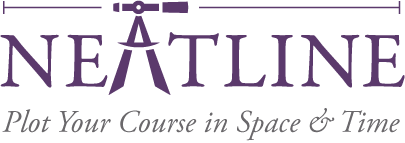Neatline from 10,000 Meters
At a glance
- Neatline is built as a set of plugins for Omeka, a web publishing framework designed for scholars and archivists.
- Neatline adds an interactive map-making environment that makes it possible to create Neatline exhibits, each of which is populated with its own collection of records, which can optionally be synchronized with items in the underlying Omeka collection.
- Neatline can be used out-of-the-box with modern geography base layers like OpenStreetMap or the Google API layers. If you want to add custom base layers or overlays, you’ll need to host them using a piece of software called Geoserver.
Omeka: Standards-compliant Metadata
Neatline is built as a suite of modular plugins for Omeka, a digital collection-management and web-publishing framework developed by the Roy Rosenzweig Center for History and New Media at George Mason University. Omeka is similar to other popular content management systems like Wordpress or Drupal, but it’s designed specifically around the needs of scholars and archivists.
Omeka makes it posible to create and curate a collection of “items” (the rough equivalent of a Wordpress “post” or a Drupal “node”), each of which is a fully-qualified Dublin Core metadata record. Once you’ve built out a collection of items using the Omeka administrative interface, the collection is automatically published as a public-facing website, which can be tailored to the needs of specific projects with custom themes and plugins.
Neatline: Interactive Map-making Environment
Building on the foundation provided by Omeka, Neatline is a plugin that grafts new functionality onto the core Omeka feature set. Neatline adds an interactive map-making environment that makes it possible to create Neatline exhibits, each of which is populated with its own collection of records, which can optionally be synchronized with items in the underlying Omeka collection.
Think of exhibits as the “canvas” for a project, records as the “paint strokes.” Exhibit-level settings control basic defaults like the starting base layer, the focus location of the map, and which of the mix-and-match UI widgets are enabled for the exhibit. Meanwhile, content inside the exhibits is represented as a collection of records, each of which corresponds to some kind of visual or textual entity in the environment - vector annotations on the map, events on the timeline, overlayed historical maps, textual annotations in the exhibit narrative, or clickable waypoints.
Geoserver: High-performance Map Server
Out of the box, Neatline can be used to build exhibits on top of a collection of modern-geography base layers - the OpenStreetMap tile set, the Google Maps API, and a collection of stylized layers created by a design firm in San Francisco called Stamen Design.
If you want to use Neatline with georectified historical maps or custom base layers, you’ll need to publish the layers to the web using a third piece of software called Geoserver, an open-source geospatial server that does the computationally-intensive work of piping the georeferenced image tiles into the Neatline exhibits.
For more, see Installing Geoserver.
